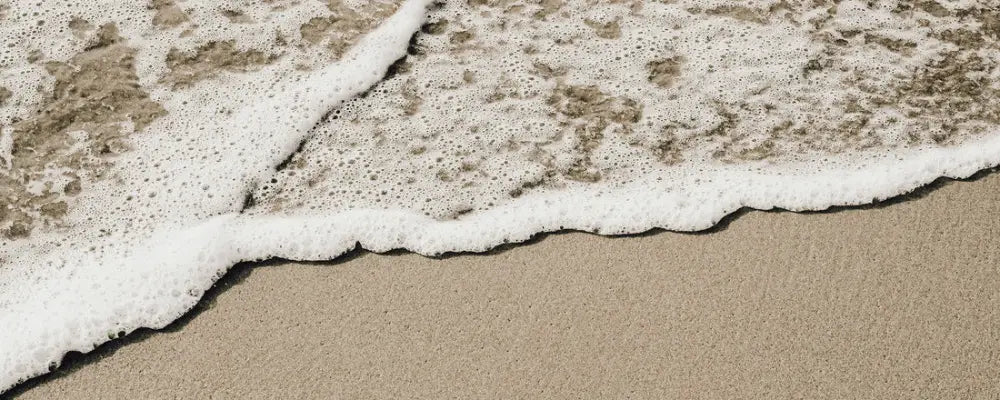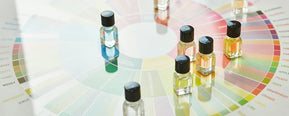Ambergris is a quiet marvel—rare, ocean-born, and long admired in the world of fine fragrance. Often called “floating gold,” it’s a substance shaped by the sea and time, known for its soft, musky scent that lingers like a memory.
Both mysterious and deeply aromatic, ambergris adds depth and longevity to perfumes. In this guide, we explore what ambergris smells like and how Buchart Colbert captures its beauty in modern fragrance compositions.
What Is Ambergris?
Ambergris is a rare, waxy substance produced in the digestive system of sperm whales (Physeter macrocephalus). When sharp, indigestible parts of the whale’s prey—such as squid beaks—irritate the gut, the whale produces a protective, fatty secretion to encase them. This substance is eventually released from the whale’s body as a natural byproduct. Once in the ocean, the mass hardens over time, shaped by exposure to salt water, sunlight, and air, transforming into a highly valued ingredient in perfumery.
Where is ambergris found?
Ambergris is most often found washed ashore on beaches in regions where sperm whales are known to frequent, including parts of the Maldives, New Zealand, the Caribbean, and occasionally along coastlines in Africa, South America, and even Europe. While it’s often discovered in less-traveled areas, it can surface anywhere sperm whales inhabit the surrounding waters.
It was once thought to be hardened sea foam, coral, or even the droppings of giant birds. Only with the rise of commercial whaling in the 1800s did scientists confirm its true source—the deep-diving sperm whale.
Historically, people speculated about what ambergris is used for, believing it to be everything from sea foam to divine resin. Once prized in medicine and ritual, its true olfactory value came to light only centuries later.
Its story, however, is much older. Fossilised evidence of ambergris dates back nearly 1.75 million years. Historical records suggest it has been collected and used by humans for over a thousand years. Across cultures and coastlines, it’s been known as “floating gold” and “the treasure of the sea.”
Smooth or rough in texture, ambergris ranges in appearance from charcoal-black to silvery-white. It often resembles driftwood or stone. But to those who know its worth, it’s a treasure—both rare and revered.
What Does Ambergris Smell Like?
Ambergris has a woody, musky, sweet-earthy, and subtly marine scent profile. It is complex, often compared to a blend of sandalwood, sea breeze, sun-dried tobacco, and aged leather.
Freshly expelled ambergris has a harsh, marine odor. But as it ages—sometimes for years at sea—its scent matures into something far more refined. The transformation is remarkable: what was once animalic and overwhelming becomes mellow, warm, and deeply inviting.
Mature ambergris has been described as smelling like a blend of old wood, sun-dried seaweed, tobacco, and clean skin. There are often whispers of vanilla, soft leather, and salt air woven through. Some compare it to sandalwood for its creamy, woody qualities—others to the dry, cool must of a well-loved book.
Its aroma can vary slightly depending on its composition and how long it’s been aged. Pale, sun-bleached ambergris tends to have a lighter, sweeter scent, while darker pieces are often more intense and earthy.
Ambergris possesses a distinctive scent often described as sweet, ambery, and deeply oceanic. Its aroma—rich, heady, and slightly animalic—can evoke the essence of marine life, with notes ranging from warm, musky depths to a soft, powdery sweetness. As it cures over years in the ocean, the scent matures, becoming increasingly complex and highly prized by perfumers.
So, is ambergris a scent in itself? Absolutely. Though subtle, it’s distinct and incredibly valuable in perfumery, not only for its smell but for the way it deepens and anchors other notes, allowing a fragrance to unfold more slowly, and last longer on the skin.
Why Is Ambergris Used in Perfume?
Ambergris plays an essential role in perfume creation. It serves two key functions: first, it helps a fragrance last longer on the skin, known as its fixative quality. Second, it adds a subtle, warm depth that enriches the overall composition.
Because of its unique molecular makeup, ambergris allows other notes in a perfume to unfold slowly, revealing themselves in layers over time. This makes the fragrance feel more complete, more natural, and more luxurious.
In fine perfumery, especially in eaux de parfum, it’s not just about the first impression—it’s about how a scent evolves. Ambergris gives perfumes a soft, enduring base that lingers beautifully.
How Is Ambergris Used in Perfume?
Before ambergris can be used in a perfume, it goes through a process called tincturing. This involves soaking the material in alcohol, which draws out its fragrance. The tincture is then aged, often for months, until it reaches the desired scent quality.
Once ready, it’s usually added to the base notes of a perfume—the part that lasts the longest. This is where ambergris quietly works its magic, blending other ingredients together and helping the perfume stay on the skin for hours.
Given the rarity and ethical concerns around natural ambergris, Buchart Colbert uses refined synthetic alternatives to recreate its iconic scent profile. This approach offers a responsible, modern interpretation while maintaining the luxurious character ambergris is known for.
At Buchart Colbert, we do not use natural ambergris. Instead, we work with synthetic analogs—carefully designed molecular recreations that capture the essence of ambergris’s marine-like scent. These materials offer a similar olfactory profile without relying on animal-derived ingredients. They are not restricted by IFRA and are not classified as allergens, allowing us to use them safely and transparently.
When this scent impression appears in our compositions, we refer to it simply as amber—a nod to its character rather than its origin. This use of the term is distinct from the traditional “amber” accord found in classic French perfumery, which is built around labdanum and vanilla. That particular accord, while warm and resinous, is unrelated to ambergris, and we do not use or label it as amber in our fragrances.
Our approach reflects both our creative values and our ethical standards: embracing modern innovation while honoring the timeless richness of perfumery.
The Allure of Ambergris in Modern Perfumery
Ambergris is more than a rare ingredient—it’s a reminder of nature’s quiet artistry. For those wondering what ambergris smells like, the answer lies not just in its scent but in the experience it creates. Ambergris carries a warmth and depth that’s hard to define yet instantly recognizable—an aroma that lingers, evolves, and anchors the memory of a fragrance.
If you're drawn to indie perfume brands that evolve, that unfold slowly and reveal more with time, Buchart Colbert is where that journey begins.
Explore the collection and experience the depth of modern scent craftsmanship.
FAQs
1. Why is ambergris so expensive?
Ambergris is incredibly rare. It forms naturally in sperm whales and can float in the ocean for years before washing ashore. Only a small amount is ever found, and aged ambergris—valued for its smooth, complex scent—is even rarer. Its scarcity, long maturation process, and ability to elevate perfumes make it one of the most prized materials in high perfumery.
2. What does ambergris look like?
It resembles a waxy, irregular lump—grey, brown, or black in color. Aged ambergris can be light and smooth, often mistaken for driftwood or stone. Its scent evolves over time from sharp and marine to warm, sweet, and musky, making it unmistakable to those who know its worth.
3. Is ambergris legal?
The legality of ambergris varies significantly by country, depending on how it is classified under environmental and wildlife protection laws.
In many countries, including the UK and across the EU, it is legal to collect and sell ambergris if it is naturally expelled by sperm whales and found on beaches. Because it is considered a byproduct, it's not subject to the same bans as other whale-derived substances. CITES (Convention on International Trade in Endangered Species) does not restrict its trade, as it treats ambergris as an excretion rather than a body part.
However, the situation is quite different in countries like the United States and Australia. In the U.S., ambergris is effectively banned under the Endangered Species Act, which prohibits the possession or trade of any product derived from endangered species—including sperm whales—regardless of whether the animal was harmed. Australia also bans its trade and export under environmental laws, treating it as a regulated whale product.


